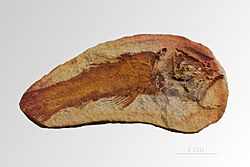Whiteia facts for kids
Quick facts for kids WhiteiaTemporal range: Triassic
|
|
|---|---|
 |
|
| Whiteia woodwardi in Muséum de Toulouse | |
| Scientific classification | |
| Kingdom: | |
| Phylum: | |
| Subphylum: | |
| Class: | |
| Order: | |
| Family: |
Whiteiidae
|
| Genus: |
Whiteia
Moy-Thomas, 1935
|
| Species | |
|
|
Whiteia is an extinct type of coelacanth fish that lived a very long time ago. These ancient fish swam in the waters of what is now Madagascar and Canada during the Early Triassic period. This was a time when dinosaurs were just starting to appear on Earth! Whiteia helps scientists understand more about how fish have changed over millions of years.
Contents
What is a Coelacanth?
Ancient Fish with Special Fins
Coelacanths are a very old group of fish. They are sometimes called "living fossils" because they look very similar to their ancestors from millions of years ago. Whiteia belongs to this amazing group.
Coelacanths are known for their unique, fleshy, lobe-like fins. These fins are different from the ray-like fins of most modern fish. Scientists believe these special fins might have been an early step in the evolution of limbs for land animals.
When Did Whiteia Live?
The Triassic Period
Whiteia lived during the Early Triassic period. This period started about 252 million years ago and ended about 201 million years ago. The Triassic period followed a huge extinction event that wiped out most life on Earth.
During the Triassic, life slowly recovered and new groups of animals appeared. This was the dawn of the dinosaurs! The world was warmer than it is today, and the continents were joined together in one supercontinent called Pangaea.
Where Did Whiteia Live?
Ancient Waters of Madagascar and Canada
Fossils of Whiteia have been found in two very different parts of the world: Madagascar and Canada. This tells us that these fish were spread out across ancient oceans.
Finding fossils in such distant places helps scientists piece together what the Earth looked like millions of years ago. It also shows how widely these ancient coelacanths could travel.
Discovering Whiteia
How Scientists Learn About Extinct Fish
Scientists learn about extinct animals like Whiteia by studying their fossils. Fossils are the preserved remains or traces of ancient life. They can be bones, teeth, or even impressions in rock.
The genus Whiteia was first described in 1935 by a scientist named Moy-Thomas. He studied the fossil remains to understand what these fish looked like and how they lived.
Different Kinds of Whiteia
There are several known species within the Whiteia group. Each species has slight differences that help scientists tell them apart. Some of these species include:
- Whiteia africanus
- Whiteia nielseni
- Whiteia oishii
- Whiteia tuberculata
- Whiteia woodwardi
Sometimes, scientists discover that a fossil they thought was a new species is actually the same as one already known. For example, a species once called Coelacanthus evolutus is now considered to be the same as Whiteia woodwardi. This happens when new evidence or better fossils are found.
Why is Whiteia Important?
Studying Whiteia and other ancient coelacanths helps us understand the history of fish. It shows us how different types of fish evolved over millions of years. It also gives clues about the ancient environments they lived in.
By looking at their fossils, scientists can learn about their size, what they might have eaten, and how they moved through the water. This helps us build a picture of life on Earth long, long ago.

